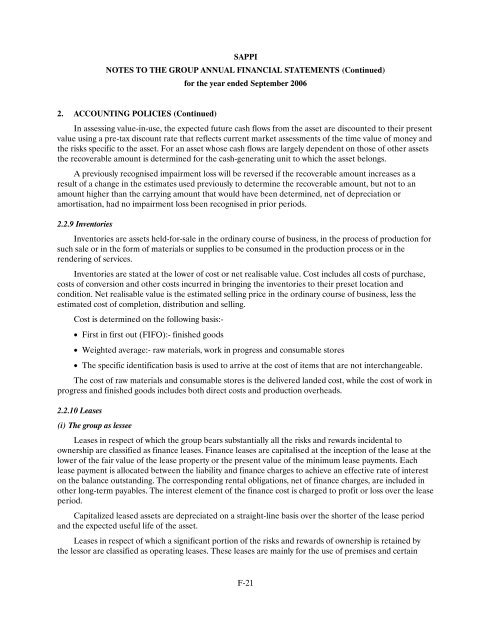You also want an ePaper? Increase the reach of your titles
YUMPU automatically turns print PDFs into web optimized ePapers that Google loves.
SAPPI<br />
NOTES TO THE GROUP ANNUAL FINANCIAL STATEMENTS (Continued)<br />
2. ACCOUNTING POLICIES (Continued)<br />
for the year ended September <strong><strong>20</strong>06</strong><br />
In assessing value-in-use, the expected future cash flows from the asset are discounted to their present<br />
value using a pre-tax discount rate that reflects current market assessments of the time value of money and<br />
the risks specific to the asset. For an asset whose cash flows are largely dependent on those of other assets<br />
the recoverable amount is determined for the cash-generating unit to which the asset belongs.<br />
A previously recognised impairment loss will be reversed if the recoverable amount increases as a<br />
result of a change in the estimates used previously to determine the recoverable amount, but not to an<br />
amount higher than the carrying amount that would have been determined, net of depreciation or<br />
amortisation, had no impairment loss been recognised in prior periods.<br />
2.2.9 Inventories<br />
Inventories are assets held-for-sale in the ordinary course of business, in the process of production for<br />
such sale or in the form of materials or supplies to be consumed in the production process or in the<br />
rendering of services.<br />
Inventories are stated at the lower of cost or net realisable value. Cost includes all costs of purchase,<br />
costs of conversion and other costs incurred in bringing the inventories to their preset location and<br />
condition. Net realisable value is the estimated selling price in the ordinary course of business, less the<br />
estimated cost of completion, distribution and selling.<br />
Cost is determined on the following basis:-<br />
• First in first out (FIFO):- finished goods<br />
• Weighted average:- raw materials, work in progress and consumable stores<br />
• The specific identification basis is used to arrive at the cost of items that are not interchangeable.<br />
The cost of raw materials and consumable stores is the delivered landed cost, while the cost of work in<br />
progress and finished goods includes both direct costs and production overheads.<br />
2.2.10 Leases<br />
(i) The group as lessee<br />
Leases in respect of which the group bears substantially all the risks and rewards incidental to<br />
ownership are classified as finance leases. Finance leases are capitalised at the inception of the lease at the<br />
lower of the fair value of the lease property or the present value of the minimum lease payments. Each<br />
lease payment is allocated between the liability and finance charges to achieve an effective rate of interest<br />
on the balance outstanding. The corresponding rental obligations, net of finance charges, are included in<br />
other long-term payables. The interest element of the finance cost is charged to profit or loss over the lease<br />
period.<br />
Capitalized leased assets are depreciated on a straight-line basis over the shorter of the lease period<br />
and the expected useful life of the asset.<br />
Leases in respect of which a significant portion of the risks and rewards of ownership is retained by<br />
the lessor are classified as operating leases. These leases are mainly for the use of premises and certain<br />
F-21
















